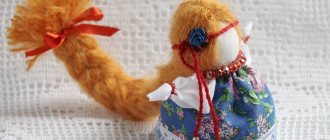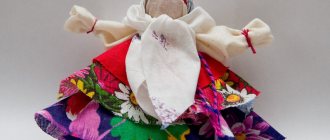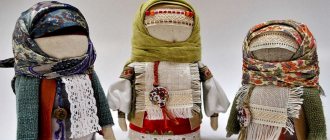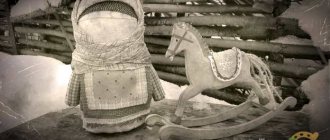The Kuvadka doll is a powerful Slavic amulet that greets a person at the moment of his birth. With its help, the husband of a woman giving birth drove away evil spirits from her, protecting not only his beloved, but also his future son or daughter.
Even a novice needlewoman can make this amulet. Our master classes at the end of the article will help her with this. But first, let’s get acquainted with the history of Kuvadka and the rules for using the amulet.
How the amulet doll Kuvadka appeared
One of the first amulets that greeted a Slav from birth was the Kuvadka doll. How and when she appeared, no one knows. However, we can assume what influenced the appearance of the amulet.
The Slavs were very concerned about the continuation of the Family - women gave birth to as many children as their health could bear. To make childbirth safe and protect the woman and baby from dark forces, special talismans were made in the family. They were called Kuvadki.
Kuvadki were a bunch of rag dolls. The correct amulet should have contained an odd number of figures. It was believed that if this condition is not taken into account during the creation of the talisman, it will begin to act harmfully.
Traditionally, protective dolls were created by the woman herself on the eve of childbirth. If the expectant mother did not feel well, the grandmother took over the work. Sometimes the doll was made literally a few minutes before the onset of labor.
How the Kuvada ritual was performed:
When contractions began, the woman in labor was taken to the bathhouse (it was customary among the Slavs to give birth in a bathhouse, and not in a room), and her husband was placed in the dressing room. Dressed in women's clothing, the man sat on a basket of chicken eggs. Kuvadkas were already hung on the walls of the room.
As soon as the woman began to scream, the child’s father tried to shout over her, diverting attention to himself. Evil spirits, flocking to a pure sinless soul, were deceived and went to the wrong room. They attacked the supposed mother, but she turned out to be too tough for them.
Angry, the dark creatures began to rush around the rooms, looking for something to inhabit. This is where doll-shaped traps came to the rescue. Having taken possession of the dolls, the spirits could no longer get out of them, because the dolls had no eyes - they could not see where to fly. Thus, the woman in labor and her baby received protection from evil spirits.
Detailed description of the process of making a talisman doll
Different types of Kuvadka dolls are slightly different from each other in appearance, and the process of making them is also slightly different.
The process of making the Central Russian squash
This doll is the easiest to make. In order to make it, you will need two pieces of natural white fabric - square and rectangular, and thread. Manufacturing sequence:
- the rectangular flap is carefully folded, bending on both sides, towards the center;
- the resulting roll is folded in half;
- using a tied thread, get the doll's head;
- then the square blank is rolled. Those places where the palms should be are tied with threads;
- the finished hands are secured with threads in the place where the doll’s chest should be;
- A red thread in the form of a cross is wrapped around the body. The amulet is ready.
How to make a Tula squash
In order to make this doll, you also need to prepare scraps of natural fabric and thread. They do it as follows:
- I twist the rectangular flap the way one would wring out laundry;
- the resulting bundle is folded in half so that in place of the head a ring is formed, which is pulled together with thread. This ring will be the doll's head;
- Hands are made from a square piece, tightening the edges of the roll with threads and forming palms;
- The arms and torso are also connected with threads in the form of a cross. The skirt of the resulting doll is straightened. To make this amulet, bright colored material is used.
Making Vyatka Kuvadka
This doll is slightly different from the previous two:
- the square flap is folded in half to form a triangle;
- from the junction of the ends, the triangle is rolled into a roller, from which a ring is then formed;
- a rectangular piece of material slightly larger than the first is folded and inserted into the prepared ring;
- Then, using threads, they form the body and head of the kuvadka, still making a protective cross on the chest. The hands of such a doll are more like wings. They straighten the skirt and the doll is ready.
Especially for you: Talisman hand of Fatima, meaning
The meaning of the Kukvadka doll
The Slavs used an incredibly large number of amulets - pendants, knots, rag dolls, brooms made of dried herbs. This is just a small list of sacred attributes of the life of an ancient Slav.
Some of these special, magical things were used every day, others were used only during certain periods. The latter includes the Kuvadka motanka. The doll was made on the eve of childbirth, because according to tradition it was used in the Kuvada ritual.
The meaning of the Kuvadka doll for the Slavs:
- the doll protected the woman during the sacred moment - the birth of a child;
- at the same time, Kuvadka protected the baby who had just been born from the Navi creatures;
- in addition, the motanka became a talisman for the child - it was hung over the crib so that it would protect him until he grew up.
What kind of doll is Kuvadka?
Our ancestors were much more concerned about the continuation of the Family than we, their descendants. Nowadays, many women choose not to give birth, but in the past it was customary to give birth to at least several children - the more, the better. Thanks to this, such a talisman as the Kuvadka doll was popular.
The custom of making a doll, which acts as a bait for evil spirits, has spread throughout the country. But the manufacturing result in some regions could be slightly different from a doll from another region.
Several options have survived to this day:
- Central Russian lyalka;
- Tula Kuvadka;
- Vyatka doll.
There will be a slight difference in each of these amulets, but do not worry that this will somehow affect the strength of the jerk. Whatever you make, the doll will become good protection for the woman in labor.
How to make a Kuvadka doll with your own hands
The most popular type of Slavic amulets is body jewelry. Rings, pendants, earrings, pendants are usually made of wood or metal. All this requires not only time, but also skill. This is how the stereotype took root among the people that all Slavic amulets are difficult to make. But this is a misconception.
Among the amulets made earlier, there were many practical ones - simple in appearance, made from cheap raw materials. These include the Slavic motankas - Krupenichka, Travnitsa, Podorozhnitsa and Kuvadka.
We have already introduced you to the history of the appearance of the Kuvadka amulet and told you what significance the Slavs assigned to it. Now, using our master classes, you can make such a talisman yourself. The instructions are so simple that they are suitable for children too.
Central Russian Kuvadka
The Central Russian Kuvadka is considered the easiest to make. That's where we'll start! You won’t have to prepare the materials for a long time, because for one doll you will only need two pieces of fabric, red thread and lace.
Kuvadoks need to be made in an odd number. You can wind three dolls or seven - these are good, lucky numbers. Take two different pieces of material for each doll.
The cutlets should be small in size, about the size of a palm, so we won’t need more pieces of fabric - one piece is 15x25 cm, the second is 10x15.
How to make a doll:
- We fold a large piece of paper towards the center on both sides. The sides folded towards the center should be no more than 1.5 cm wide.
- We rolled it up, now fold the fabric in half.
- We tie the folded area with thread, departing 2-3 cm from the edge.
- We make handles. Place the second piece of fabric on the table with the pattern facing down. We bend the smaller edges inward, and then one wider one. We take about a centimeter.
- Roll the fabric into a roll lengthwise and secure along the edges with thread, leaving a centimeter aside.
- We connect two blanks. We place the handles under the head, lifting the top piece of fabric. We lower it. We tie the thread under our hands. Central Russian Kuvadka is ready!
Make the required number of figures, and then fasten them together using a cord in one row.
Tula Kuvadka
Before you start working on the doll, collect materials and make blanks (the same size as in the previous master class). Check if you measured correctly.
The difference between this doll and the previous one is that its head and body are made from the same blank. Having started making the head, we will immediately make the body. In addition, the doll's head does not resemble a ball stuffed with cotton, but a twisted knot.
Step-by-step instruction:
- Take a large piece of fabric and twist it in the center. Not in a roll, but like a candy wrapper.
- Twist the fabric so that it can be bent like a loop. After folding the fabric into a circle, secure the “ends” of the twist area with thread. Let the rest of the fabric stick out down.
- We make the handles according to the same principle as in the previous master class - the fabric is patterned down, we bend it a centimeter from each edge, and we roll it up lengthwise. We form palms at the ends.
- We push the workpiece under the protruding “tails” - one from above, the other from below. We straighten the fabric of the dress and tie it under the doll’s arms with threads. Do not make a cross on the chest, otherwise this doll will not be able to attract evil spirits - on the contrary, it will begin to scare them away!
- We repeat all points with each subsequent jerk.
Vyatskaya Kuvadka
And the last of the most popular Kuvadoks is the Vyatka doll. For this we will need to slightly change the size of the blanks - take two pieces of 15x15 cm and one 15x25 cm. For this doll, it is better to take fabric of the same color.
Manufacturing process:
- We place the square so that it resembles a rhombus - not the sides, but the corners should look on the sides. We roll it from the top and bottom to the center (1 cm each). When finished, fold the two ends of the blanks together.
- Twist a loop from the roll so that the left tip points to the right and the right tip points to the left. Set the piece aside, weighing it down with something heavy, because now we will work on the second flap.
- Fold the fabric lengthwise like an accordion. Holding it so that it does not straighten out, carefully take the loop and insert the accordion into it.
- Check if the material is in the center of the knot. If not, correct her.
- Lower both halves down - one forward, the other back.
- Tie under the loop with a thread so as not to catch the ends (handles) sticking out on the sides.
- Now we tie it with thread again - this time under the handles to secure them.
- Repeat points 1-7 with other dolls.
So we finished making the Vyatka doll.
Don’t forget that the Kuvadoks need to be fastened in one row using a string or ribbon so that you can hang them on the wall.
What types are there?
There are three main types of dolls, the difference being in the techniques used to make them. The names correspond to the areas where they were made:
- Central Russian is considered traditional and more widespread. It is the easiest to make and is done quickly.
- The Tula one is unique in that its head is shaped like a ring, and the arm blank has a constriction in the middle of the flap.
- The Vyatka Kuvadka’s main difference from the others is that her arms resemble wings. This is achieved by folding the small piece into a loop to form the head and arms.
We recommend: Protection from dark forces and attraction of wealth - Krupenichka or Zernovushka doll. History, meaning and production
Central Russian
Tula
Vyatskaya
Features of handling Kuvadki
With the use of the amulet, everything is clear - the Kuvadka doll acted as a protector for Slavic women. Scared away evil spirits during childbirth. But what happened to the doll when the baby was born? There are several versions on this matter. They contradict each other, but at the same time, one of the options looks more logical than the other:
- According to one version, Kuvadka was left as an amulet for a child. The doll clung above the cradle to scare away evil spirits.
- But at the same time, it turns out that the doll was possessed by an evil spirit. He was stuck there and couldn’t get out, which means he couldn’t use such an item for protection. Therefore, the dolls were burned after the ceremony.
It is likely that the Slavs made several such amulets. One before childbirth, to protect the expectant mother and her child at a crucial moment, and the second after, to extend the protection of the child.
This is the story of Kuvadka. This seemingly simple doll protected our ancestors and can protect our children if we do not lose the traditions handed down to us and continue to make such amulets for our family.
Manufacturing rules
In order for the amulet to work, it had to be made correctly. If the doll didn’t work out the first time, that is, it came out sloppy and disheveled, it was remade. When making the amulet, the following rules were observed:
- Kuvadka dolls were made exclusively by women; men were not even allowed to be in the room where the process of creating amulets took place;
- The mother herself made dolls for herself and her baby, and if the amulets were intended as a gift to a pregnant woman, then they were made by the mother of the expectant mother or her mother-in-law;
- The process of making Kuvadka dolls was carried out exclusively during the waxing moon. It was the night luminary that endowed them with the greatest protective power;
- Before making amulets, a woman had to wash herself thoroughly and put on clean clothes. Her thoughts also had to be pure. During the process of creating dolls, you had to think about the future child, but only good things;
- Before starting work, the scraps were prepared. They had to be torn from the mother's old clothes, but before these clothes were used, they were carefully washed with the addition of salt and holy water in order to cleanse them of bad energy;
- used sledgehammers were subject to destruction. Instead, they hung new ones, and did this until the child underwent the baptismal ceremony. The dolls were then given to him as toys;
- When the baby grew up, the kuvadki were not thrown away, but put away in a specially designated place. Occasionally, the dolls were presented with small gifts to appease;
- Kuvadka amulets could not be given into the wrong hands, for example, if another child came to visit, otherwise their protective power would disappear. It was also forbidden to give someone's doll to another child;
- Often, when making a kuvadka, white spells were read, which contributed to the better protective functions of the amulets.
Especially for you: Karelian amulets dolls











